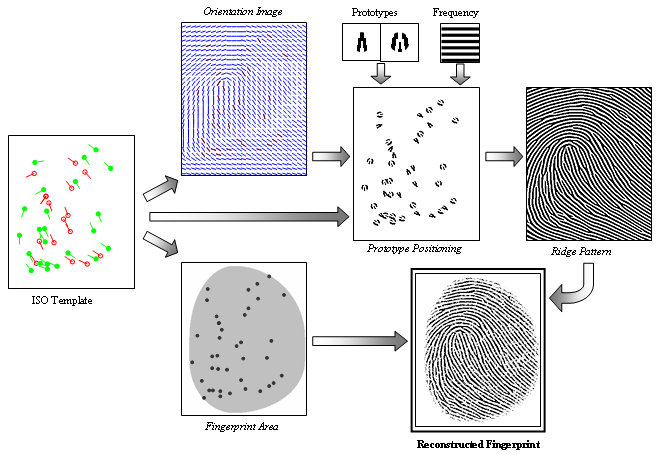|

Home

People

Research

Publications

Resources

Related Links
|
|
Reconstruction from TemplateWhy reconstructing fingerprint images from templates?Considering the growing diffusion of fingerprint-based systems in large-scale applications and the efforts towards interoperability, it is definitely urgent to carefully investigate to what extent an image reconstructed from a template may be similar to the original fingerprint. In particular, it is important to understand whether such a reconstructed fingerprint image can fool: (1) a human expert examiner; (2) an automatic recognition system through a masquerade attack. The approach proposed by BioLabGiven the information stored in an ISO template (size and resolution of the image and list of the minutiae), the reconstruction approach is based on a sequence of steps that attempt to estimate various aspects of the original unknown fingerprint: 1) the fingerprint area, 2) the orientation image, and 3) the ridge pattern. - The fingerprint area is estimated according an elliptical model by minimizing the area that encloses all the minutiae in the template.
- The orientation image is estimated by optimizing the parameters of an orientation model in order to find the "best fitting" to the known minutiae directions.
- The fingerprint pattern is generated by minutiae prototype positioning and iterative pattern growing, starting from the orientation image and a constant frequency image. The iterative pattern growing consists in iteratively growing the minutiae prototypes by applying at each pixel a Gabor filter adjusted according to the local frequency and orientation until whole image has not been covered.
Finally a noising and rendering procedure is executed.
ResultsFrom the results of many systematic experiments carried out against nine state-of-the-art mathers, the following conclusions may be drawn: (1) it is very unlikely to fool a human expert, do to a lack of information in the standard template itself, which does not allow details such as the local shape of the minutiae or evident pores to be reconstructed; (2) it is definitely possible to successfully attack automatic recognition systems (with an average percentage of successful attacks against nine different systems of 81% at a high security level and 90% at a medium security level).  Comparison between a real fingerprint and the image reconstructed from its template Comparison between a real fingerprint and the image reconstructed from its template
Bibliography(Click here if you are interested in any of the publications below) | A. Adler and R. Cappelli, "Template Security", in Stan Z. Li and Anil K. Jain (Editors), Encyclopedia of Biometrics (second edition), Springer, 2015. |  | A. Adler and R. Cappelli, "Template Security", in Stan Li (Editor), Encyclopedia of Biometrics, Springer, 2009.  Abstract Abstract |  | R. Cappelli, A. Lumini, D. Maio and D. Maltoni, "Fingerprint Image Reconstruction from Standard Templates", IEEE Transactions on Pattern Analysis Machine Intelligence, vol.29, no.9, pp.1489-1503, September 2007.  Abstract Abstract |  | R. Cappelli, A. Lumini, D. Maio and D. Maltoni, "Evaluating Minutiae Template Vulnerability to Masquerade Attack", in proceedings 5th Workshop on Automatic Identification Advances Technologies (AutoID2007), Alghero, June 2007.  Abstract Abstract |  | R. Cappelli, A. Lumini, D. Maio and D. Maltoni, "Can Fingerprints be Reconstructed from ISO Templates?", in proceedings International Conference on Control, Automation, Robotics and Vision (ICARCV2006), Singapore, pp.191-196, December 2006.  Abstract Abstract |
|


